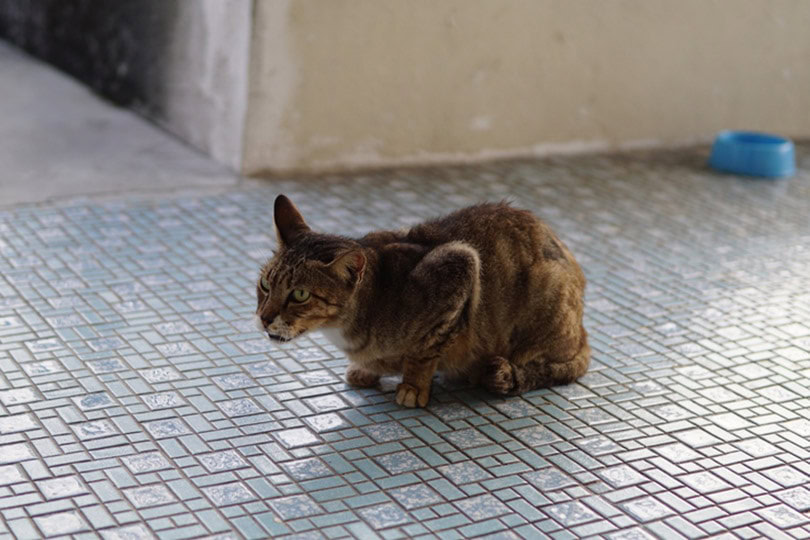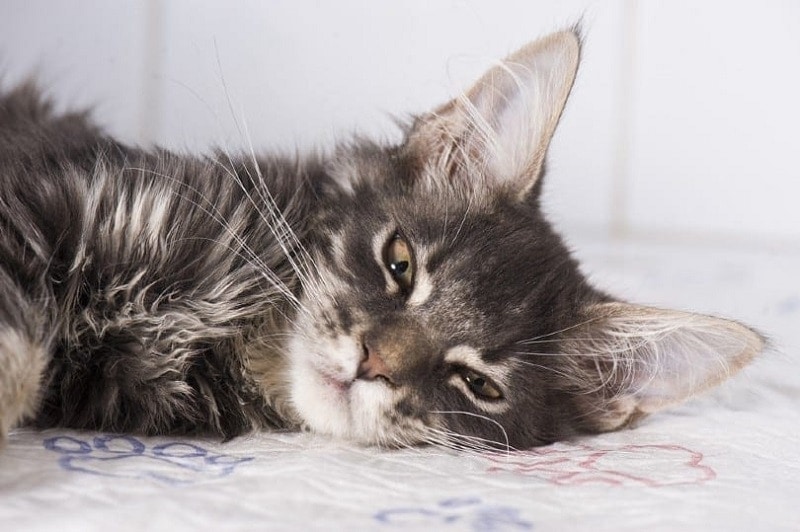VET APPROVED

The information is current and up-to-date in accordance with the latest veterinarian research.
Learn more »Click to Skip Ahead
Mercury poisoning is a health issue of historical significance for humans and animals. Many people have heard of the phrase “mad as a hatter,” a comparison used to describe the unfortunate symptoms of chronic mercury poisoning in Victorian hat makers, but what does this have to do with our feline friends?
The following article examines mercury poisoning in cats—including its causes, signs, and care of affected felines—to illuminate how this condition remains relevant for 21st-century pet owners.

What is Mercury Poisoning?
- Elemental Mercury: Often referred to as quicksilver, elemental mercury is the shiny silver metal in older thermometers and fluorescent lightbulbs. Although it is a liquid at room temperature, it can evaporate into a toxic vapor if it is released from a damaged product or device.
- Inorganic Mercury: Inorganic mercury is commonly found in the environment and may combine with other elements to form inorganic salts in the soil.
- Organic Mercury: Methylmercury is the most common form of organic mercury and forms as a result of inorganic mercury cycling through the environment. Mercury present in the air or on land will eventually settle into bodies of water, accumulating in the tissues of fish and shellfish. Larger fish that eat other smaller fish typically contain the highest levels of methylmercury.
Poisoning or toxicity can occur secondary to exposure to any of the above-noted forms of mercury. It may result in damage or the dysfunction of the immune, digestive, integumentary, and nervous systems. Additionally, impaired kidneys and abnormal fetal development can also be secondary to mercury poisoning.

What Are the Signs of Mercury Poisoning?
The signs associated with mercury poisoning in felines vary depending on the dose and duration of exposure, as well as the specific form of mercury-causing toxicity.
- Blindness
- Incoordination
- Muscle weakness
- Tremors or convulsions
- Nystagmus (abnormal, involuntary eye movement)
- Abnormal, exaggerated movements of the limbs
- Anorexia
- Depression
- Paralysis
Young, developing kittens are especially sensitive to the effects of organic mercury poisoning and may exhibit jerky, uncoordinated movements and death secondary to exposure. While less common, the signs of mercury poisoning secondary to inhalation of elemental mercury may include difficulty breathing, respiratory compromise, and death, in addition to the signs noted above.
Mercury poisoning from the ingestion of inorganic mercury often includes signs such as anorexia, vomiting, diarrhea, inflammation of the mouth and esophagus, and pain due to the compound’s corrosive nature. Sudden death may also occur.
What Are the Causes of Mercury Poisoning?
The most common route of mercury exposure for pets is ingesting fish containing methylmercury. Fish with high levels of mercury include tuna, swordfish, king mackerel, marlin, shark, and tilefish. Methylmercury ingested from dietary sources is rapidly absorbed in the gastrointestinal tract; however, clinical signs may not become apparent for several weeks after initial exposure.
While felines are especially sensitive to even low doses of methylmercury, toxicity from other forms of mercury may also occur. Pets may be exposed to elemental mercury from products such as older thermometers, appliances, thermostats, or automotive parts. Some types of sporting equipment, imported skin creams, and jewelry or antiques may also be implicated in cases of elemental mercury poisoning.
Most exposures to elemental mercury occur when it is inadvertently released from a broken or damaged product. Liquid elemental mercury is absorbed poorly through the skin. However, inhaling the toxic vapor created as this substance evaporates leads to rapid absorption and severe clinical signs.

How Do I Care for a Pet With Mercury Poisoning?
If your cat is feeling unwell or you have concerns regarding mercury poisoning, prompt veterinary attention is recommended. While the clinical signs discussed above may indicate potential mercury poisoning, this condition is generally considered to be uncommon in felines, and your veterinary team will likely consider a variety of other conditions.
If your veterinarian diagnoses your cat with mercury poisoning and treatment is advised, options may include medications used to bind mercury in the gastrointestinal tract and limit its absorption, such as activated charcoal. Antioxidants, such as vitamin E and selenium, may also be used to limit cellular damage caused by mercury. Lastly, chelation therapy used to bind mercury in the blood may be beneficial in cases of recent exposure.
While treatment options for this condition exist, the neurologic and renal (kidney) damage caused by mercury is permanent, and treatment of affected cats may be unrewarding. Unfortunately, the prognosis for complete recovery in animals affected by mercury poisoning is very poor.

Frequently Asked Questions (FAQs)
How Is Mercury Poisoning Diagnosed?
Your veterinarian may diagnose mercury poisoning based on your cat’s history, signs, and laboratory test results. Evaluating mercury concentrations in soft tissues, such as the kidneys or liver, may demonstrate abnormally elevated levels of this heavy metal. Other lab work, such as a urinalysis, complete blood count, and blood chemistry, may support a diagnosis of mercury poisoning.

How Can I Prevent Mercury Poisoning in My Cat?
Ingestion of methylmercury-containing fish is the most common route of mercury exposure in humans and pets. Unfortunately, data on the levels of mercury in commercial cat foods is lacking, and there are currently no regulations regarding mercury concentrations in pet foods in the United States.
While no documented cases of mercury poisoning from a commercial diet have been reported, if you have concerns regarding this risk, avoiding daily feeding of tuna-based cat foods may be considered a preventative measure. Additionally, avoiding albacore tuna is wise.

Conclusion
In summary, mercury poisoning is an uncommon yet severe condition affecting felines. If you have any concerns regarding your cat’s health or their risk for this condition, a discussion with your veterinarian is an appropriate next step—they are best suited to advise you on the well-being of your furry family member.
Featured Image Credit: Iryna Mylinska, Shutterstock











